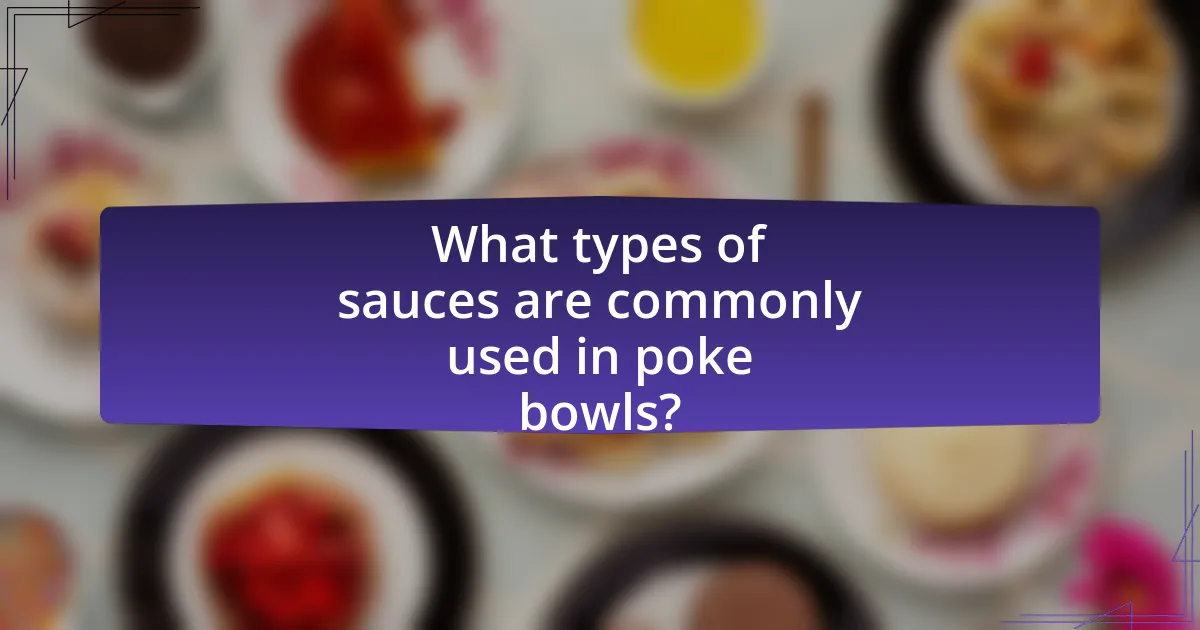The article focuses on the critical role of sauces in crafting the perfect poke bowl dressing, emphasizing their contribution to flavor, balance, and complexity. It outlines how various sauces, such as soy sauce, sesame oil, and spicy mayo, enhance the overall taste profile by adding umami, acidity, and sweetness. The discussion includes key flavor components, the impact of sauce selection on the dish, and techniques for achieving a harmonious balance of flavors. Additionally, it addresses common mistakes to avoid and offers tips for customizing sauces to suit personal preferences and dietary restrictions, ultimately highlighting the importance of sauces in creating a satisfying poke bowl experience.

What is the role of sauces in crafting the perfect poke bowl dressing?
Sauces play a crucial role in crafting the perfect poke bowl dressing by providing flavor, balance, and complexity to the dish. The right sauce enhances the freshness of the ingredients, such as fish and vegetables, while also adding umami, acidity, and sweetness. For example, traditional poke dressings often include soy sauce, which contributes saltiness and depth, while sesame oil adds nuttiness. Additionally, sauces can help to unify the various components of the poke bowl, ensuring that each bite is harmonious. The effectiveness of sauces in poke bowls is supported by culinary practices that emphasize the importance of flavor layering, which is essential for creating a satisfying and well-rounded meal.
How do sauces enhance the flavor profile of a poke bowl?
Sauces enhance the flavor profile of a poke bowl by adding depth, complexity, and balance to the dish. The combination of ingredients in sauces, such as soy sauce, sesame oil, and spicy mayo, introduces umami, sweetness, and acidity, which complement the fresh fish and vegetables. For instance, soy sauce provides a salty umami flavor that elevates the taste of raw fish, while sesame oil adds a nutty richness. Additionally, spicy mayo contributes creaminess and heat, creating a well-rounded flavor experience. This layering of flavors is essential in poke bowls, as it transforms simple ingredients into a harmonious and satisfying meal.
What are the key flavor components in poke bowl sauces?
The key flavor components in poke bowl sauces include soy sauce, sesame oil, and citrus juice. Soy sauce provides umami and saltiness, while sesame oil adds a nutty richness. Citrus juice, often lime or yuzu, contributes acidity and brightness, balancing the flavors. These components work together to enhance the overall taste profile of the poke bowl, making it savory, rich, and refreshing.
How do different sauces complement various poke bowl ingredients?
Different sauces enhance poke bowl ingredients by adding flavor, texture, and balance. For instance, soy sauce complements fish like tuna and salmon by providing umami, while spicy mayo adds creaminess and heat, enhancing the taste of vegetables and proteins. Additionally, ponzu sauce, with its citrus notes, brightens the flavors of avocado and seaweed, creating a refreshing contrast. Each sauce interacts uniquely with the ingredients, ensuring a harmonious blend of tastes and textures in the poke bowl.
Why is the choice of sauce crucial in poke bowl preparation?
The choice of sauce is crucial in poke bowl preparation because it significantly influences the overall flavor profile and balance of the dish. A well-selected sauce enhances the freshness of the ingredients, complements the textures, and ties together the various components, such as fish, vegetables, and grains. For instance, traditional sauces like soy sauce or ponzu provide umami and acidity, which can elevate the taste experience. Additionally, the right sauce can cater to dietary preferences and enhance the visual appeal of the poke bowl, making it more appetizing.
What impact does sauce selection have on the overall dish?
Sauce selection significantly influences the overall dish by enhancing flavors, textures, and visual appeal. In the context of a poke bowl, the right sauce can elevate the freshness of the fish, balance the dish’s components, and provide a cohesive taste experience. For instance, a soy-based sauce adds umami, while a citrus-based dressing can introduce acidity, brightening the flavors. Studies show that sauces can account for up to 30% of a dish’s flavor profile, underscoring their critical role in culinary satisfaction.
How can sauce choices reflect personal taste preferences?
Sauce choices can reflect personal taste preferences by indicating an individual’s flavor profile, such as sweetness, spiciness, or acidity. For instance, a preference for sweet sauces like teriyaki suggests a liking for sugary flavors, while a choice for spicy sauces like sriracha indicates a tolerance or preference for heat. Research shows that flavor preferences are often shaped by cultural background and individual experiences, which further influences sauce selection. Therefore, the sauces chosen for dishes like poke bowls serve as a direct expression of one’s unique palate and culinary inclinations.

What types of sauces are commonly used in poke bowls?
Commonly used sauces in poke bowls include soy sauce, ponzu sauce, spicy mayo, and sesame oil. Soy sauce serves as a traditional base, providing umami flavor, while ponzu sauce adds a citrusy twist. Spicy mayo, a blend of mayonnaise and sriracha, offers creaminess and heat, and sesame oil contributes a nutty aroma. These sauces enhance the overall taste and balance of the poke bowl, making them essential components in crafting a flavorful dish.
What are the most popular sauces for poke bowls?
The most popular sauces for poke bowls include soy sauce, ponzu sauce, spicy mayo, and sesame oil. Soy sauce serves as a traditional base, providing a salty umami flavor, while ponzu sauce adds a citrusy twist. Spicy mayo, a blend of mayonnaise and sriracha, offers a creamy and spicy kick, and sesame oil contributes a nutty aroma and taste. These sauces are widely used due to their ability to enhance the freshness of the fish and other ingredients in poke bowls.
How do traditional Hawaiian sauces differ from modern variations?
Traditional Hawaiian sauces primarily utilize natural ingredients like soy sauce, sesame oil, and local fruits, emphasizing fresh, simple flavors that reflect the islands’ agricultural heritage. In contrast, modern variations often incorporate processed ingredients, such as high-fructose corn syrup and artificial flavorings, leading to sweeter and more complex profiles that cater to contemporary palates. For example, traditional poke sauces typically rely on a balance of umami and acidity, while modern adaptations may include additional spices and condiments, altering the original taste and texture.
What are the unique characteristics of each sauce type?
Each sauce type used in poke bowls has distinct characteristics that enhance the dish’s flavor profile. Soy sauce is salty and umami-rich, providing a savory base. Ponzu sauce combines citrus and soy, adding brightness and acidity. Spicy mayo, made from mayonnaise and sriracha, offers creaminess with heat. Sesame oil contributes a nutty flavor, while miso paste adds depth and sweetness. Each sauce type plays a crucial role in balancing flavors and textures, making them essential for crafting the perfect poke bowl dressing.
How can homemade sauces elevate a poke bowl experience?
Homemade sauces can significantly elevate a poke bowl experience by enhancing flavor, providing freshness, and allowing customization. These sauces, such as spicy mayo or sesame dressing, can complement the natural taste of the fish and vegetables, creating a more balanced and enjoyable dish. Additionally, homemade sauces often use fresh ingredients, which can improve the overall quality and healthiness of the meal. Customization through homemade sauces enables individuals to tailor the flavor profile to their preferences, making each poke bowl unique and satisfying.
What ingredients are essential for crafting a homemade poke bowl sauce?
Essential ingredients for crafting a homemade poke bowl sauce include soy sauce, sesame oil, rice vinegar, and optional additions like sriracha or honey for flavor enhancement. Soy sauce serves as the primary base, providing umami, while sesame oil adds a nutty aroma. Rice vinegar contributes acidity, balancing the flavors. The optional ingredients can introduce heat or sweetness, allowing customization based on personal preference.
How can one customize sauces to suit dietary restrictions?
One can customize sauces to suit dietary restrictions by substituting ingredients that align with specific needs, such as using gluten-free soy sauce for those with gluten intolerance or replacing dairy with plant-based alternatives for lactose intolerance. For example, a traditional poke bowl sauce often contains soy sauce, which can be swapped for tamari to accommodate gluten-free diets, while coconut milk can replace cream in creamy sauces for dairy-free options. These substitutions ensure that the flavor profile remains intact while adhering to dietary requirements, allowing individuals to enjoy their meals without compromising their health needs.

What techniques can be used to balance flavors in poke bowl dressings?
Techniques to balance flavors in poke bowl dressings include adjusting acidity, sweetness, saltiness, and umami. For instance, incorporating ingredients like rice vinegar or citrus juice can enhance acidity, while honey or agave syrup can add sweetness. Saltiness can be achieved through soy sauce or miso, and umami can be introduced with ingredients like sesame oil or seaweed. These adjustments create a harmonious flavor profile, ensuring that no single element overpowers the others, which is essential for a well-rounded poke bowl dressing.
How can one achieve the perfect balance of sweet, salty, and umami in sauces?
To achieve the perfect balance of sweet, salty, and umami in sauces, one should use a combination of ingredients that contribute to each flavor profile. For sweetness, ingredients like honey or sugar can be added; for saltiness, soy sauce or salt is effective; and for umami, options such as miso paste or fish sauce work well.
The key is to start with a base and gradually incorporate each element, tasting as you go to ensure the flavors harmonize. For example, a common ratio might involve equal parts of sweet and salty, with umami added to taste, allowing for adjustments based on personal preference. This method is supported by culinary principles that emphasize balance in flavor profiles, ensuring that no single taste overpowers the others.
What role does acidity play in enhancing poke bowl sauces?
Acidity plays a crucial role in enhancing poke bowl sauces by balancing flavors and elevating overall taste. The presence of acidic ingredients, such as citrus juices or vinegar, helps to cut through the richness of proteins like fish and avocado, creating a more harmonious flavor profile. Additionally, acidity can enhance the perception of freshness and brightness in the sauce, making the dish more appealing. Studies in culinary science indicate that acidity can stimulate the palate, leading to increased salivation and a heightened sensory experience, which is essential for dishes like poke bowls that rely on a variety of textures and flavors.
How can texture be incorporated into poke bowl dressings?
Texture can be incorporated into poke bowl dressings by using ingredients that provide varying levels of creaminess, crunch, and thickness. For example, creamy elements like avocado or tahini can create a smooth base, while adding crunchy components such as toasted sesame seeds or chopped nuts enhances the overall mouthfeel. Additionally, incorporating thickening agents like Greek yogurt or miso paste can add body to the dressing, making it more substantial. These textural contrasts not only elevate the sensory experience but also complement the fresh ingredients typically found in poke bowls, creating a balanced and enjoyable dish.
What are some common mistakes to avoid when crafting poke bowl sauces?
Common mistakes to avoid when crafting poke bowl sauces include using overly salty ingredients, neglecting balance in flavors, and failing to consider the sauce’s compatibility with the poke bowl’s components. Overly salty ingredients, such as soy sauce, can overpower the dish, while a lack of flavor balance—between sweet, salty, and acidic—can result in a one-dimensional sauce. Additionally, not considering how the sauce interacts with the fish, vegetables, and rice can lead to an unharmonious overall taste. These factors are crucial for achieving a well-rounded and enjoyable poke bowl experience.
How can over-seasoning affect the overall dish?
Over-seasoning can negatively impact the overall dish by overpowering the natural flavors of the ingredients. When a dish is excessively seasoned, it can lead to an unbalanced taste profile, making it overly salty, spicy, or bitter, which detracts from the intended culinary experience. For example, in a poke bowl, the delicate flavors of fresh fish and vegetables can be masked by too much soy sauce or seasoning, resulting in a dish that lacks harmony. This imbalance can also lead to a less enjoyable eating experience, as the palate may become overwhelmed, making it difficult to appreciate the individual components of the dish.
What should be considered when pairing sauces with poke bowl ingredients?
When pairing sauces with poke bowl ingredients, it is essential to consider the flavor profiles, textures, and overall balance of the dish. The sauce should complement the freshness of the fish and vegetables while enhancing their natural flavors. For example, a soy-based sauce pairs well with salmon due to its umami richness, while a citrus-based sauce can brighten the taste of tuna. Additionally, the texture of the sauce should align with the ingredients; thicker sauces can coat ingredients effectively, while lighter sauces may allow for a more delicate balance. This approach ensures that each component of the poke bowl harmonizes, creating a cohesive and enjoyable eating experience.
What tips can help in creating the perfect poke bowl dressing?
To create the perfect poke bowl dressing, balance flavors by combining salty, sweet, sour, and umami elements. A common base includes soy sauce for saltiness, sesame oil for richness, and rice vinegar for acidity. Adding ingredients like honey or agave syrup introduces sweetness, while fresh citrus juice enhances brightness. Incorporating ingredients such as miso paste or fish sauce can deepen umami flavors. For texture, consider adding sesame seeds or chopped scallions. This approach ensures a well-rounded dressing that complements the fresh ingredients in a poke bowl.



